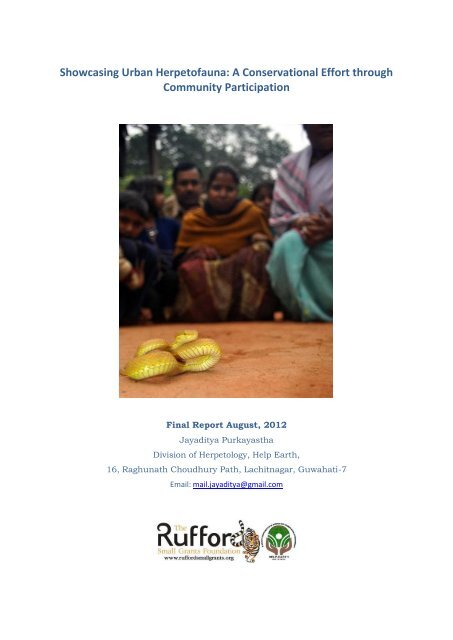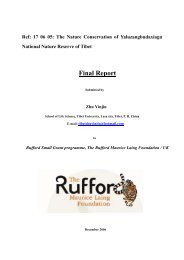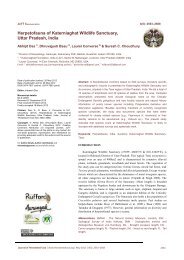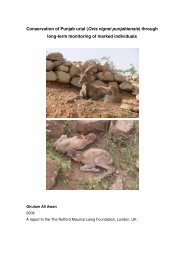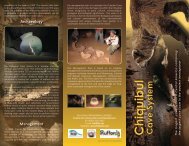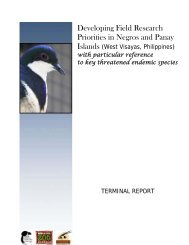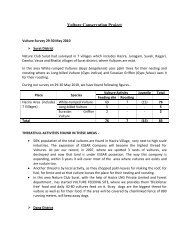Showcasing Urban Herpetofauna: A Conservational Effort through ...
Showcasing Urban Herpetofauna: A Conservational Effort through ...
Showcasing Urban Herpetofauna: A Conservational Effort through ...
Create successful ePaper yourself
Turn your PDF publications into a flip-book with our unique Google optimized e-Paper software.
<strong>Showcasing</strong> <strong>Urban</strong> <strong>Herpetofauna</strong>: A <strong>Conservational</strong> <strong>Effort</strong> <strong>through</strong><br />
Community Participation<br />
Final Report August, 2012<br />
Jayaditya Purkayastha<br />
Division of Herpetology, Help Earth,<br />
16, Raghunath Choudhury Path, Lachitnagar, Guwahati-7<br />
Email: mail.jayaditya@gmail.com
ACKNOWLEDGEMENTS<br />
First and foremost, I would like to thank Rufford Small Grants Foundation, the<br />
sponsor, of this research work for financial support. I thank Help Earth and Dept.<br />
Of Zoology, Arya Vidyapeeth College for research and logistic support. Thanks to my<br />
employing institution, South Point School, for always being there for me. Thanks<br />
are also due to the following institutions for the support provided at various levels:<br />
Assam Forest Department, Gauhati University, North Orissa University, Tezpur<br />
University, Assam State Zoo Cum Botanical Garden, Zoological Survey of India,<br />
Wild Life Trust of India, G.M.D.A. and The Assam Tribune. My gratitude to my<br />
teachers/inspiration Saibal Sengupta, Gernot Vogel,Aaron Bauer, Patrick David, P.<br />
C. Bhattacharjee, Indraneil Das, Sushil Kr. Dutta. Thanks Abhijit Das, M. Firoz<br />
Ahmed, Kaushik Deuti, B.H.C.K. Murthy, Stephen Mahony, Masafumi Matsui,<br />
Varad Giri, Ashok Captain, Romulus Whitaker, Darrel Frost, Peter Uetz for<br />
supporting and inspiring at different stages of my research career. Thanks to my<br />
lab mates and seniors Bakhtiar Hussain, Nipendra Kr. Choudhury, Jayanta Gogoi,<br />
Prashanta Kr. Choudhury, Ruli Borthakur, Madhurima Das, Mitali Chetia,<br />
Geetoshree Goswami and Dipankar Dutta for their support. I am grateful to<br />
Krishnanjan Chanda, Principal, South Point School who relentlessly encouraged my<br />
research endeavours, supporting my success and reassuring me in my failures.<br />
Last and most importantly, I thank nature for creating such beautiful group of<br />
animals, the amphibians and the reptiles.<br />
All the Photographs (Animals) used within are by Jayaditya Purkayastha except<br />
Nilssonia hurum by M. Firoz Ahmed (Plate 4 C)<br />
2
PROJECT TEAM<br />
3
Contents<br />
Introduction 6<br />
<strong>Urban</strong> <strong>Herpetofauna</strong> 6<br />
About Guwahati 8<br />
Important threats 9<br />
Material and Methods 9<br />
Scientific Findings 11<br />
A list of Amphibians and Reptiles 13<br />
Plate 1: Some of the frogs of Guwahati 16<br />
Plate 2: Some of the lizards of Guwahati 17<br />
Plate 3: Some of the snakes of Guwahati 18<br />
Plate 4: Some of the turtles of Guwahati 19<br />
References 20<br />
Publications 21<br />
Awareness and conservational efforts 23<br />
Media Coverage 29<br />
Links of newspaper article 30<br />
Book links 30<br />
5
Introduction<br />
<strong>Herpetofauna</strong> comprises collectively of amphibian and reptilian fauna. The study of<br />
this group of animals is called Herpetology. The term “herpetology” is derived from<br />
the Greek word “herpes” which means creeping things- an attribute of the way the<br />
animals move. Among vertebrates, this group of animals are the least worked on.<br />
Our India has a rich diversity of herps comprising of about 800 known species<br />
(Uetz, 2012). North-eastern India is one of the prominent regions of India in terms<br />
of its rich biodiversity. The North-eastern Indian region is also a part of Indo Burma<br />
bio geographic hotspot. The environmental conditions and forest type existing in the<br />
region makes it extremely conducive for the existence of amphibians and reptiles.<br />
From this region 272 species of herps are reported till date (Ahmed et al., 2009)<br />
with even more waiting to make it to the record books, with the highest<br />
concentration found in undisturbed natural habitats. Unfortunately, however no<br />
organised data exists on the herpetofauna residing in urban environments of the<br />
country. Since many representatives of this group of animals are apt enough to take<br />
advantage of the urbanised condition, a study of the herpetofauna in the light of<br />
urbanised setup becomes imperative for long term conservation measures and risk<br />
assessment.<br />
<strong>Urban</strong> <strong>Herpetofauna</strong><br />
Since urban habitats are different from a typical wild animal abode, only the<br />
specialised animals can utilize the resources that an urban setup provides. Those<br />
species that can adapt to such challenges have a better chance of thriving as they<br />
have to withstand far less competition in the future. From the evolutionary<br />
perspective too, urban species are very important. <strong>Urban</strong> areas are evolutionary<br />
laboratories. For example, Johnston and Selander (1964) found that the House<br />
Sparrows (Passer domesticus) introduced into the United States in 1879, evolved<br />
into new races within 50 years.<br />
Since only specialized organisms can live here, so either one has to be born<br />
specialized to take advantages as we human beings do, or one has to develop it,<br />
allowing some modifications in body design, food requirement and so on leading to<br />
a change. One such highly adaptable group of animals is perhaps the herpetofauna.<br />
Almost nothing is known about effect of urbanisation on herps. For most, the word<br />
wildlife is generally confined to big, illustrious and charismatic animals like<br />
6
mammals, birds etc and their conservation becomes a source of national concern<br />
and tops the list of conservational agenda. The herps and such other ignored and<br />
overlooked animals receive the least scientific and conservational attention. In fact<br />
the diversity of herps in an urban settlement is far than that of any other so called<br />
illustrious animals. Some of the herps such as common toads, wall lizards and<br />
such other species thrive in urbanized setup. Thus, ample scope still remains for<br />
these opportunistic species in such environments.<br />
<strong>Urban</strong>isation, where in one hand destroys the habitat of some organisms, at the<br />
same time makes way for certain other groups to survive. In fact urban setup may<br />
provide high food supply (including feeding by people), a large variety of new<br />
ecological niches and the lack of predators attracting animals to these centres.<br />
Thus, the terminology “Habitat Destruction”, which is flashed and highlighted in the<br />
field of conservation, must be rather used selectively. The term “Habitat<br />
Destruction”, in broad sense should rather be discouraged. Rather, “Habitat<br />
alteration” is a better selection of word when we wish to address habitat broadly.<br />
The rate at which, urbanisation is griping the world, a well documented study is<br />
imperative to assess its impact on the non human inhabitants. But the problem<br />
with such studies is lack of collaboration and co-ordination between<br />
conservationists and developers. Developers are rather weary of conservationists<br />
believing that the latter may suddenly pop up a species in their work site that<br />
would require immediate attention from conservational point of view thereby<br />
jeopardizing their work progress and causing them economic loss. Also the<br />
development and economy are very closely related and are interdependent on one<br />
another. The study site being tagged as the gateway of north-eastern India becomes<br />
of more importance in terms of economy and development of the state. Thus,<br />
addressing the issue of conservation of herps and habitat becomes of prime<br />
importance. Apart from these obstacles, there is also an urgent need to learn more<br />
about the effects of urban development on wildlife, so the effects can be mitigated in<br />
the future.<br />
Unsurprisingly, a search in IUCN red list for Homo sapiens (Human) shows that we<br />
human beings are categorised under the “least concern” group as our population<br />
shows an increasing trend. From this we can summarise that our population is not<br />
going to decrease any time soon. So, the only way to minimise the effect of<br />
urbanisation on biodiversity is to reduce resource utilisation to the extent possible<br />
so as to leave some for our neighbouring wild life. It has been said that the battle<br />
7
for life on earth will be won or lost in urban areas and indeed this is the only<br />
biodiversity that many people experience. Furthermore green patches in urban<br />
areas are also very important for human beings, offering valuable and much<br />
appreciated opportunities for exercise, social interaction, relaxation and peace.<br />
If we fail to retain green areas, there will be negative impacts on ecological systems,<br />
to the extent that in coming decades we may face an ecological system that is totally<br />
flawed in function. Not that the deterioration has not already started, but the rate<br />
at which the whole alteration process is going on, more drastic events awaits us in<br />
near future.<br />
About Guwahati<br />
Guwahati (26.1859°N, 91.7477°E) is the capital city of the state of Assam with a<br />
total area of 216.79 sq. km. having a population of around 1,100,000 with a<br />
population density of 2695.43 per sq km. It is a city striving restlessly to make it to<br />
the list of metro cities in India. It is also the largest metropolis in the North-eastern<br />
region of India. It is said to be the "Gateway" of the North East Region as well as the<br />
business capital of the region. Ecologically as well the city is important, as it is a<br />
part of Indoburma bio geographic hotspot. Guwahati enjoys a tropical monsoon<br />
climate and receives about 1,600 mm annual rainfall, with an average annual<br />
temperature of 23°C. Certain patches of forest still exist within the city. The overall<br />
habitat type mainly comprises of forest patches, scrublands, grasslands,<br />
plantations, wetlands, agricultural lands and human settlements. The forest<br />
patches are of moist deciduous type. The city is surrounded by eighteen hills along<br />
with an internationally acclaimed wetland, the Deeporbeel, which is a RAMSAR site.<br />
Status of herps in Guwahati: The city has a wide diversity of herpetofauna<br />
accounting for at least 63 species in and around it. Because of the wide diversity of<br />
species present here, the conservational issue is of much importance. Apart from<br />
the core reason – urbanisation, there are many other reasons about which herps<br />
and the people devoted to their conservation need to worry. One of the most<br />
unfortunate of these is the misinformation and superstations that exists amongst<br />
the masses regarding herps (mainly snakes) that is in the way of their conservation.<br />
8
Important threats faced by the herps of Guwahati:<br />
Filling up and pollution of water bodies resulting in a lack of breeding<br />
ground, mainly for amphibians.<br />
Cutting down of remaining green patches and mining activities.<br />
Construction activities such as building of roads mainly the national<br />
highways which causes fragmentation of forests.<br />
Malicious killing mainly because of ignorance and superstition.<br />
Human consumption mainly of turtles is decimating turtle population.<br />
Other reasons include tarring of roads, accidental road kills, and gillnet<br />
fishing.<br />
Fertilisers and pesticides cause major threats to amphibians.<br />
In the urban environment, another problem that herps, more specifically<br />
amphibians face is the lack of breeding grounds as most of the land is<br />
concretized with no terrestrial water bodies. Also the temporary potholes<br />
within the city acts as death traps for the tadpoles as these holes dry up very<br />
rapidly.<br />
Due to ecological imbalance, the prey and predator ratio is getting out of proportion.<br />
Thus, many snakes venture into human habitation areas for easy procurement of<br />
food. This human snake encounter has three potential outcomes. In most cases it<br />
results in the death of the snake, or if the animal is lucky enough, it is rescued. The<br />
rescue process has its own short comings as most of the rescued snakes are<br />
released in the same spot leading to artificial population rise of that species in that<br />
particular area, making the snake again move back to human habitation areas,<br />
starting a cycle of release and recapture. The third consequence and the rarest one<br />
are human casualties because of snake bite.<br />
Material and Methods<br />
The study was conducted from September 2011 to July 2012. The field survey was<br />
carried out during both day and night, and four man hours was invested per<br />
survey. The survey was carried out in the morning mostly from 06:00h till noon and<br />
in the evening mostly from 17:00 to 20:00h. Few late night surveys extending up to<br />
sunrise were also conducted to find nocturnal species. Visual Encounter Survey<br />
(Crump and Scott, 1994) employing randomized walk (Lambert, 1984) was<br />
9
carried out along with active searches. Specimen were collected, photographed,<br />
identified using literature and field guide (Smith 1931, 1935, 1943; Ahmed, Das<br />
and Dutta 2009) and released. Few specimens were preserved in 10% buffered<br />
formalin and are in personal collection of first author. For survey purposes the city<br />
was divided into three groups:<br />
Commercial Areas: Panbazar (26.1859°N, 91.7477°E), Fancy Bazar (26.1830°N,<br />
91.7429°E), and Christian Basti (26.1552°N, 91.78°E).<br />
Residential Areas: Lachitnagar (26.1695°N, 91.7563°E), Lokhra (26.1106°N,<br />
91.7465°E), Kala Pahar (26.1519°N, 91.7465°E), Geetanagar (26.1750°N,<br />
91.7952°E), Bhangagarh (26.1620°N, 91.7672°E), Maligaon (26.1556°N,<br />
91.6906°E), Hatigaon (26.1278°N, 91.7855°E), and Kamakhya (26.1642°N,<br />
91.7076°E).<br />
Forested Areas: Amchang Reserve Forest (26.1891°N, 91.8464°E), Hengrabari<br />
Reserve Forest (26.1618°N, 91.7843°E), Jalukbari Reserve Forest (26.1441°N,<br />
91.6614°E), Deeporbeel Wildlife Sanctuary (26.13055N, 91.6591E), and Sarania<br />
Reserve Forest (26.1769°N, 91.7599°E). The classification of the commercial and<br />
residential areas was done as per Guwahati Municipal Corporation (GMC)<br />
regulations and Forest Reserves are considered under Forest Areas.<br />
Acronyms used: GMDA: Guwahati Metropolitan Development Authority, GMC:<br />
Guwahati Municipal Corporation, CA: Commercial Areas, RA: Residential Areas, FA:<br />
Forested Areas, RF: Reserve Forests, IUCN: International Union for the<br />
Conservation of Nature and Natural Resources, IWPA: Indian Wildlife Protection<br />
Act, EW: Extinct In Wild, VU: Vulnerable, LC: Least Concerned, LR-nt: Lower<br />
Risk/near threatened, LR-lc: Lower Risk/least concerned, DD: Data Deficient, NE:<br />
Not Evaluated, NS: Non Scheduled, I: Schedule I, II: Schedule II, IV: Schedule IV, C:<br />
Common, M: Moderate and R: Rare.<br />
Awareness campaigns were carried out <strong>through</strong> talk shows, presentations,<br />
workshops, seminars and field trips. Both electronic and print media was used to<br />
promote our mission. Awareness and promotional materials such Mugs, t-shirts,<br />
stickers with conservation message were made and distributed. A book on <strong>Urban</strong><br />
<strong>Herpetofauna</strong> was prepared.<br />
10
Scientific Findings:<br />
In this study we found 63 species of herpetofauna. Amphibians constituted of 17<br />
species belonging to 7 families and reptiles of 46 species belonging to 11 families.<br />
Among the amphibians the most commonly encountered was Duttaphrynus<br />
melanostictus, found in and around small, water bodies with or without vegetation<br />
cover. Hylarana leptoglossa was sighted in the marshes of the residential areas<br />
(Lachitnagar, Bhangagarh, Hatigaon) during the initial phase of the study. However<br />
with the filling up of these water bodies, they disappeared from the residential areas<br />
and could be encountered only in the forest areas exhibiting an extremely patchy<br />
distribution, with fewer sightings. Humerana humeralis and Hylarana leptoglossa<br />
displayed a similar distributional pattern. Microhyla ornata, Fejervarya teraiensis,<br />
Fejervarya nepalensis, Fejervarya pierrei and Polypedates leucomystax were located<br />
in patches in few of the residential localities (Lachitnagar, Lokhra, Geetanagar,<br />
Maligaon, Hatigaon). Interestingly Polypedates leucomystax was found around some<br />
of the swimming pools in the study site. Duttaphrynus melanostictus, Fejervarya<br />
syhadrensis and Euphlyctis cyanophlyctis were found to be hardy and were<br />
encountered in most of the areas including the commercial areas. Leptobrachium<br />
smithi and Clinotarsus alticola were encountered only in and around the streams in<br />
forest areas. Their tadpoles were found in aggregation in slow flowing parts of<br />
streams amidst aquatic vegetation. Hylarana tytleri was sighted moderately only in<br />
the littoral forest and among water hyacinth (Eichornia crassipes) of Deeporbeel.<br />
Amongst reptiles, the most commonly sighted lizard species was Hemidactylus<br />
frenatus. We observed five species of lizards in all the three classes of study area.<br />
However, Gekko gecko was observed only in some old trees of commercial and<br />
residential areas showing a patchy distribution in the study sites. Varanus<br />
bengalensis was extremely rare (2 sightings). Ptyctolaemus gularis, Hemidactylus<br />
garnotii, Hemidactylus platyurus, Eutropis macularia and Sphenomorphus maculatus<br />
along with a Draco species were encountered only in the forest areas. Draco sp. was<br />
encountered only once and considered as extremely rare. Hemidactylus flaviviridis<br />
was encountered only in some pockets of commercial areas (Purkayastha and Das,<br />
2009). Cnemaspis assamensis, Cyrtodactylus khasiensis and Lygosoma<br />
albopunctata are found mostly in forested areas. Though Cyrtodactylus khasiensis<br />
and Lygosoma albopunctata were occasionally seen in residential areas, Cnemaspis<br />
assamensis which is thought to be primarily a forest dwelling lizard was once<br />
encountered on the wall of a residence in Kamakhya area.<br />
11
Amongst snakes, Xenochrophis piscator was the most commonly encountered<br />
species. We observed eight species of snakes that appeared to have more or less<br />
uniform distribution, occurring in all the three classes of study sites (see table 1).<br />
Of these, the sighting rates of Lycodon aulicus increased during the study period<br />
and the species was rescued frequently from buildings (mostly from gaps in<br />
between the bricks of un-plastered wall of buildings) in residential areas and the<br />
commercial area. With clearing of secondary forests and bushes, and also the<br />
disappearance of thatched houses, this species was probably forced to move to the<br />
buildings in search of food and a secure place to reside and retreat. Eight species of<br />
snakes were found both in residential and forest areas and six species were<br />
recorded only from the forest areas. Interestingly we could encounter (once) Pareas<br />
monticola only in the residential area and due to paucity of data we failed to provide<br />
a logical explanation for this pattern of distribution but presume that it could have<br />
been released by the snake charmers. Among terrapins, we found Nilssonia<br />
nigricans, Aspideretes gangeticus, Nilssonia hurum and Pangshura sylhetensis in the<br />
temple ponds of Kamakhya, which in all likelihood could find their way to these<br />
water bodies <strong>through</strong> offerings by the devotees to the deity. Morenia petersi were<br />
also reported from the study area more specifically from Deeporbeel (Das and<br />
Sengupta, 2010; Baruah and Sharma, 2010). Among the study sites, Deeporbeel<br />
was found to be most species rich with 38 species and found to support rare and<br />
least known species like Xenochrophis cerasogaster, Xenochrophis schnurrenbergeri<br />
and Morenia petersi.<br />
12
Amphibians<br />
A list of Amphibians and Reptiles encountered in our Survey<br />
Frogs and Toads<br />
Family: Bufonidae<br />
Duttaphrynus melanostictus (Schneider, 1799) Common Asian Toad<br />
Family: Megophryidae<br />
Leptobrachium smithi (Matsui, Nabhitabhata and Panha, 1999) Red-Eyed Frog<br />
Family: Microhylidae<br />
Microhyla ornate (Duméril and Bibron, 1841) Ornate Narrow-mouthed Frog<br />
Family: Rhacophoridae<br />
Philautus garo (Boulenger, 1919) Garo Hills Bush Frog<br />
Polypedates teraiensis (Dubios, 1987) Six-lined Tree Frog<br />
Family: Dicroglossidae<br />
Fejervarya nepalensis (Dubois, 1975) Nepal Cricket Frog<br />
Fejervarya pierrei (Dubois, 1975) Pierre’s Cricket Frog<br />
Fejervarya syhadrensis (Annandale, 1919) Small Cricket Frog<br />
Fejervarya teraiensis (Dubois, 1975) Terai Cricket Frog<br />
Euphlyctis cyanophlyctis (Schneider, 1799) Skittering Frog<br />
Hoplobatrachus tigerinus (Daudin, 1802) Indian Bullfrog<br />
Family: Ranidae<br />
Clinotarsus alticola (Boulenger, 1882) Assam Hills Frog<br />
Hylarana tytleri (Theobald, 1868) Theobald’s Ranid Frog<br />
Humerana humeralis (Boulenger, 1887) Bhamo Frog<br />
Sylvirana leptoglossa (Cope, 1868) Cope’s Assam Frog<br />
13
Amolops assamensis (Sengupta et al., 2008) Sengupta’s Cascade Frog<br />
Caecilian<br />
Family: Ichthyophiidae<br />
Ichthyophis garoensis (Pillai and Ravichandran, 1999) Garo Hills Caecilian<br />
Class: Reptilia<br />
Lizards<br />
Family: Agamidae<br />
Calotes versicolor (Daidin, 1802) Common Garden Lizard<br />
Ptyctolaemus gularis (Peters, 1864) Blue-throated Lizard<br />
Family: Gekkonidae<br />
Hemidactylus frenatus (Duméril and Bibron, 1836) Common House Gecko<br />
Hemidactylus brookii (Gray, 1845) Brook’s House Gecko<br />
Hemidactylus garnotii (Duméril and Bibron, 1836) Garnot’s House Gecko<br />
Hemidactylus platyurus (Scheider, 1792) Flat-tailed House Gecko<br />
Hemidactylus flavoviridis (Rüppell, 1835) Yellow-bellied Gecko<br />
Hemidactylus aquilonius (McMahan and Zug, 2007) Northern House Gecko<br />
Gekko gecko (Linnaeus, 1758) Tokay Gecko<br />
Cnemaspis assamensis (Das and Sengupta, 2000) Assamese Day Gecko<br />
Cyrtodactylus khasiensis (Jerdon, 1870) Khasi Hills Bent-toed Gecko<br />
Family: Scindae<br />
Eutropis multifasciata (Kuhl, 1820) Many Lined Skink<br />
Eutropis macularia (Blyth, 1853) Bronze Skink<br />
Sphenomorphus maculates (Blyth, 1853) Spotted Forest Skink<br />
Family: Varanidae<br />
Varanus bengalensis (Daudin, 1802) Bengal Monitor Lizard<br />
14
Snakes<br />
Family: Typhlopidae<br />
Ramphotyphlops braminus (Daudin, 1803) Brahminy Blindsnake<br />
Typhlops diardii (Schlegal, 1839) Diard’s Blindsnake<br />
Family: Biodae<br />
Python bivittatus (Kuhl, 1820) Burmese Python<br />
Family: Colubridae<br />
Enhydris enhydris (Schneider, 1799) Rainbow Water Snake<br />
Lycodon aulicus (Linnaeus, 1758) Common Wolf Snake<br />
Pareas monticola (Cantor, 1839) Assam Snail Snake<br />
Ptyas mucosa (Linnaeus, 1758) Rat Snake<br />
Ptyas korros (Schlegal, 1837) Indo-Chinese Rat Snake<br />
Rhabdophis subminiatus (Schlegal, 1837) Red-necked Keelback<br />
Dendrelaphis proarchos (Wall, 1909) Painted Bronzeback<br />
Oligodon albocinctus (Cantor, 1839) White-barred Kukri Snake<br />
Amphiessma stolatum (Linnaeus, 1758) Buff Striped Keelback<br />
Boiga gokool (Gray, 1835) Eastern Cat Snake<br />
Xenochrohis piscator (Schneider, 1799) Checkered Keelback<br />
Xenochrohis schnurrenbergeri (Kramer, 1977) Bar-necked Keelback<br />
Xenochrohis cerasogaster (Cantor, 1839) Painted Keelback<br />
Psammodynastes pulverulentus (Boie, 1827) Common Mock Viper<br />
Coelognathus radiates (Schlegal, 1837) Copper-headed Trinket Snake<br />
Ahaetulla nasuta (Laćèpede, 1789) Long-nosed Whip Snake<br />
Chrysopelea ornata (Shaw, 1802) Ornate Flying Snake<br />
Family: Elapidae<br />
Naja naja (Linnaeus, 1758) Binocled Cobra<br />
15
Naja kaouthia (Lesson, 1831) Monocled Cobra<br />
Bungarus fasciatus (Schneider, 1801) Banded Krait<br />
Turtles and Tortoises<br />
Family: Trionychidae<br />
Nilssonia gangeticus (Kuvier, 1825) Ganges Soft-shellled Turtle<br />
Nilssonia nigricans (Anderson, 1875) Black Soft-shelled Turtle<br />
Nilssonia hurum (Gray, 1831) Peacock Soft-shelled Turtle<br />
Family: Geoemydidae<br />
Pangshura sylhetenis (Jerdon, 1870) Assam Roofed Turtle<br />
Pangshura tentoria (Gray, 1834) Indian Tent Turtle<br />
Pangshura tecta (Gray, 1831) Indian Roofed Turtle<br />
Morenia petersi (Anderson, 1879) Indian Eyed Turtle<br />
16
Plate 1: Some of the frogs of Guwahati, Assam, India<br />
A: Duttaphrynus melanostictus; B: Leptobrachium smithi; C: Fejervarya pierrei; D:<br />
Hoplobatrachus tigerinus; E: Hylarana tytleri; F: Humerana humeralis; G: Hylarana<br />
leptoglossa; H: Polypedates teraiensis.<br />
17
Plate 2: Some of the lizards of Guwahati, Assam, India<br />
A: Calotes versicolor; B: Hemidactylus frenatus; C: Hemidactylus brookii; D:<br />
Hemidactylus platyurus; E. Hemidactylus flaviviridis; F. Gekko gecko; G. Eutropis<br />
multifasciata; H. Sphenomorphus maculatus.<br />
18
Plate 3: Some of the snakes of Guwahati, Assam, India<br />
A: Enhydris enhydris; B: Xenochrophis schnurrenbergeri C: Xenochrophis<br />
cerasogaster; D: Rhabdophis subminiatus; E: Amphiesma stolatum; F: Chrysopelea<br />
ornate; G: Boiga gokool; H: Bungarus fasciatus.<br />
19
Plate 4: Some of the turtles of Guwahati, Assam, India<br />
A: Nilssonia nigricans, B: Nilssonia gangeticus, C: Nilssonia hurum, D: Pangshura<br />
sylhetensis, E: Pangshura tecta, F: Pangshura tentoria<br />
20
References<br />
Ahmed, M.F., Das, A., Dutta, S.K. (2009): Amphibians and Reptiles of Northeast India, A<br />
Photographic Guide. Aaranyak, Guwahati. xiv + 170 pp.<br />
Baruah, C., Sharma, D.K. (2010): Indian eyed Turtle Morenia petersi (Anderson, 1879) in the<br />
Deepor beel, Ramsar site. Reptile Rap. 9: 6-7.<br />
Crump, M.L., Scott, N.J. (1994): Visual encounter surveys. In: Heyer, W.R., Donnelly, M.A.,<br />
McDiarmid, R.W., Hayek, L.C., Foster, M.S. Eds., Measuring and Monitoring Biological<br />
Diversity: Standard Methods for Amphibians. Smithsonian Institution Press, Washington,<br />
D.C<br />
Das, I., Sengupta, S. (2010): Morenia petersi Anderson 1879 – Indian eyed turtle. In: Rhodin,<br />
A.G.J., Pritchard, P.C.H., van Dijk, P.P., Saumure, .A., Buhlmann, K.A., Iverson, J.B., and<br />
Mittermeier, R.A. Eds., Conservation Biology of Freshwater Turtles and Tortoises: A<br />
Compilation Project of the IUCN/SSC Tortoise and Freshwater Turtle Specialist Group.<br />
Chelonian Research Monographs No. 5, pp. 045.1–045.5.<br />
Johnston, R. F., Selander, R. K. (1964): House sparrows: rapid evolution of races in North<br />
America, Science. 144 (3618) 550–552.<br />
Lambert, M.R.K. (1984): Amphibians and reptiles. In: Cloudsley- Thompson, J.L. Eds., Key<br />
Environments: Sahara Desert. Pergamon Press, London.<br />
Purkayastha, J., Das, M. (2009): Geographic distribution: Hemidactylus flaviviridis (yellow-<br />
green house gecko). Herpetol. Rev. 40: 451-452.<br />
Smith, M.A. (1931): The Fauna of British India Including Ceylon and Burma. Reptilia and<br />
Amphibia. 1 (Loricata, Testudines). London, Taylor & Francis.<br />
Smith, M.A. (1935): The Fauna of British India, including Ceylon and Burma. Reptiles and<br />
Amphibia, 2 (Sauria) in: London, Taylor & Francis.<br />
Smith, M.A. (1943): The Fauna of British India, Ceylon and Burma, including the whole of<br />
the Indo-Chinese Subregion. Reptilia and Amphibia. 3(Serpentes). London, Taylor & Francis.<br />
Uetz, P. (2012): The Reptile Database, http://www.reptile-database.org, accessed 7 July<br />
2012.<br />
21
Publications<br />
Book<br />
“<strong>Urban</strong> <strong>Herpetofauna</strong>”: Amphibians and Reptiles of Guwahati, A Pictorial Guide.<br />
publication during the period<br />
i. Das, M, Brahma, R.K., Purkayastha, J. (2011): More in our mind than in their<br />
mouth? A preliminary inspection inside the oral cavity of two house Geckos:<br />
Hemidactylus frenatus Schlegel, 1836 and Hemidactylus aquilonius McMahan<br />
& Zug, 2007. Herpetology Notes (4) 303-306<br />
ii. Das, M., Purkayastha, J. (2012): An insight into hemipenial morphology of<br />
five Hemidactylus Oken, 1817 (Reptilia: Gekkonidae) species of Guwahati,<br />
Assam, India. Hamadryad 36(1) 32-37<br />
iii. Purkayastha, J., Purkayastha, A. (2012): A case of White-breasted Kingfisher<br />
(Halcyon smyrnensis) Preying on a Gecko (Hemidactylus aquilonius). Asian<br />
Journal of Conservation Biology 1(1) 45-46<br />
iv. Purkayastha, J., Matsui, M. (2012): A New Species of Fejervarya (Anura:<br />
Dicroglossidae) from North-eastern India. Asian Herpetological Research. 3(1)<br />
31-37<br />
v. Jayaditya Purkayastha, Ahmed Mahmadul Hassan, Hasanul Islam, Jessica<br />
Das, Manoj Sarma, Mituseela Basumatary, Nilakshi Sarma, Nishant Chatterjee,<br />
Sachin Singha, Vishnupriya Nair, Arundhati Purkayastha, Jayashree Dutta,<br />
Madhurima Das: On the turtles of the temple pond of Kamakhya, Assam, India.<br />
(In review, Reptile Rap)<br />
vi. Jayaditya Purkayastha, Madhurima Das, Gernot Vogel: Comments on<br />
Xenochrophis cerasogaster (Cantor 1839) (Serpentes: Natricidae) with remarks<br />
on its natural history and distribution. (In Preparation)<br />
22
vii. Saibal Sengupta, Jayaditya Purkayastha, Madhurima Das, Binod Baruah:<br />
<strong>Herpetofauna</strong>l assemblage of Deeporbeel Ramsar Site, Assam, India. (In<br />
Preparation)<br />
Popular Write Ups<br />
i. Fang Facts (in English), Horzon, The Assam Tribune<br />
ii. Sohure Bonno Jibon[<strong>Urban</strong> Wildlife] (In Bengali), Shangbad Lohori<br />
iii. Shaper Shombondhe [On Snakes] (In Bengali), Shangbad Lohori<br />
23
Awareness and conservational efforts:<br />
24
Media Coverage<br />
30
Links of newspaper articles during the project period<br />
<br />
http://www.telegraphindia.com/1120316/jsp/northeast/story_15257222.jsp#.<br />
UDnhLMEgdn4<br />
<br />
http://economictimes.indiatimes.com/environment/flora-fauna/guwahati-<br />
reptiles-withstand-urbanization-onslaught/articleshow/11729221.cms<br />
<br />
http://www.assamtribune.com/scripts/detailsnew.asp?id=feb0312/at042<br />
<br />
http://articles.timesofindia.indiatimes.com/2012-04<br />
28/guwahati/31451748_1_amphibians-frog-s-day-new-species<br />
<br />
http://www.assamtribune.com/scripts/details.asp?id=apr3009/City3<br />
<br />
http://sevensisterspost.com/ngo-takes-frogs-leap-to-save-earth/<br />
<br />
http://articles.timesofindia.indiatimes.com/2012-06<br />
06/guwahati/32078068_1_saplings-world-environment-day-tree-plantation<br />
<br />
http://articles.timesofindia.indiatimes.com/2012-03-<br />
20/guwahati/31214745_1_frog-species-new-species-joint-research<br />
Book “<strong>Urban</strong> <strong>Herpetofauna</strong>: Amphibians and Reptiles of<br />
Guwahati, A pictorial guide” is available at following links<br />
<br />
http://www.chimaira.de/gp/product_info.php/language/en/info/p77237_Urba<br />
n-<strong>Herpetofauna</strong>---Amphibians---Reptiles-of-Guwahati--A-Pictorial-Guide.html<br />
<br />
http://www.dkagencies.com/doc/from/1063/to/1123/bkId/DK733233217165<br />
2582263883371/details.html<br />
31


